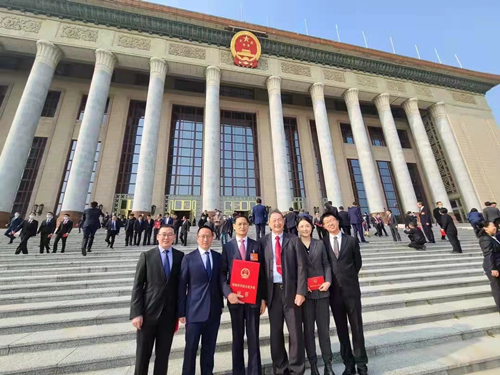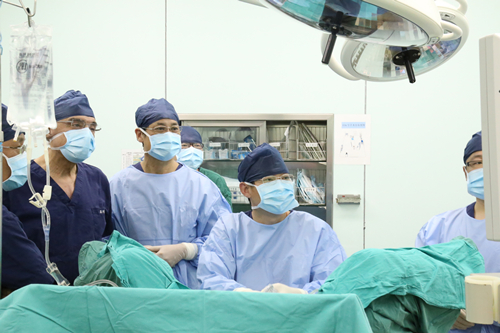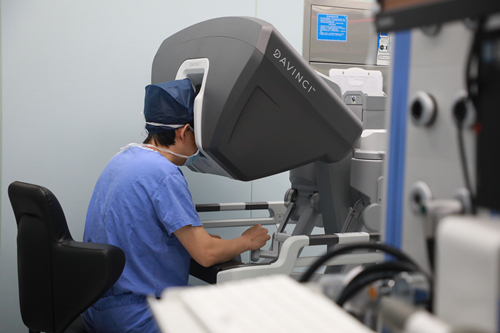- News
The Urology Team of Shanghai General Hospital Won the Second Prize of National Science and Technology Progress Award
On November 3, 2020, the National Science and Technology Award Conference was held in the Great Hall of the People in Beijing, and the project "New Theory of Prostate Trauma Repair and Precision Surgical Intervention System" led by the expert team of Urology Clinical Medical Center of our hospital won the second prize of National Science and Technology Progress Award. Prof. Xia Jueji, the leader of our Urology Center, received the award in Beijing as the first completer of the project.

Benign prostatic hyperplasia is a common disease that seriously affects the health of middle-aged and elderly men. There are about 6 million patients in China who need to receive surgical treatment. If not operated in time, it can lead to urinary retention, bladder stones, recurrent prostate bleeding, and even cause serious complications such as hydronephrosis and uremia, which can be life-threatening. However, the problems of easy recurrence after surgery, incontinence, erectile dysfunction, complications, long recovery time, and the risk of surgery for elderly makes life even harder for the patients.
For this reason, the team of the Clinical Medical Center of Urology of our hospital has spent 20 years, jointly with Zhujiang Hospital of Southern Medical University and Guizhou Provincial People's Hospital, to precisely address the current challenges of prostate enlargement surgery, and has carried out a series of innovative and pioneering researches to systematically establish a precise surgical intervention system for prostate enlargement, which has significantly improved the efficacy and treatment level of prostate enlargement surgery in China. The research results were written into European guidelines and American urology classic textbook "Campbell Walsh Urology", "Smith Urology", as well as domestic magnum opus "Wu Jieping Urology", "Guo Yinglu Male Science".

The team proposed a new theory of wound repair in prostate surgery, which laid a solid theoretical foundation to effectively prevent complications and help patients recover faster and better after surgery. The traditional view is that the repair of prostatectomy trauma is accomplished by crawling coverage of the adjacent bladder mucosa and urethral epithelium, but the team's research confirmed that stem cells of prostate trauma transdifferentiate into uroepithelial cells under the stimulation of urine and participate in trauma repair, overturning the previous understanding.
The team also innovated and established the key technology of minimally invasive anatomical prostate enucleation. It solves the problems of large open surgery trauma and TURP tissue residue and easy recurrence, and can completely enucleate the hyperplastic tissue. The team also innovated and developed a new surgical shaver to push the whole enucleated tissue into the bladder and remove it through the urethra after crushing, significantly improving the efficiency of the surgery.
The team also innovated and established the key technology of minimally invasive anatomical enucleation of prostate. The model solves the problems of large trauma in open operation, large residual TURP tissue and easy recurrence, and can completely enucleat the proliferative tissue. At the same time, a new type of surgical planer was innovated and developed to push the whole enucleated tissue into the bladder and take it out through the urethra after crushing, which significantly improved the operation efficiency.
The high price makes it difficult for the patients to afford imported thulium laser machine. With the support of National Science and Technology Support Program, the team cooperated with medical enterprises to transform the research into clinical applications. We independently develops the localized thulium laser prostate enlargement surgical treatment system - SRM-T125 type dual working mode thulium laser treatment machine. The team has successfully optimized the wavelength of thulium laser from 2.0μm to 1.94μm, further reducing the depth of thermal damage to 0.1mm, realizing the localization of the equipment, and also carrying out regional network promotion of appropriate technology and radiation application to the whole country, which has been promoted to county hospitals, benefiting the majority of grassroots patients.
From the breakthrough of new theory, to the revolution of new technology, to the research and development of new equipment, the team has been constantly improving and pursuing perfection for 20 years, and finally systematically established the precision surgical intervention system for benign prostatic hyperplasia. The establishment of this system has broken many records of benign prostatic hyperplasia surgery. The operation is faster and safer, the operation time is shortened by 32%, almost "zero bleeding", so that elderly high-risk patients can also obtain safe operation opportunities. At the same time, it also broke the "forbidden zone" that large-volume prostate can not accept traditional minimally invasive surgery. The postoperative recurrence rate decreased from 6% - 18% to 0.5% - 1%, the incidence of postoperative urinary incontinence decreased from 16% to 1.5%, and the incidence of postoperative erectile dysfunction decreased by 45.2% compared with traditional minimally invasive surgery. At present, the team has completed 8275 operations under the "precision surgical intervention system for benign prostatic hyperplasia", and extended the technical system to 688 hospitals at home and abroad, with a total number of 61700 patients.

It is worth mentioning that on the latest list of 2020 China Hospital Science and Technology Measurements (STEM) released recently, the urology department of our hospital ranks first in Shanghai and second in China, which fully shows the scientific research and comprehensive ability of the discipline. It is reported that the list was released by the Chinese Academy of Medical Sciences. The evaluation results are an evaluation system based on the three dimensions of scientific and technological output, academic influence and scientific and technological conditions with unified standards, sources and methods. The evaluation results are divided into two parts: one is the comprehensive scientific and technological value, and the other is the discipline scientific and technological value. The research objective is 1634 hospitals in China, and it has been released annually since 2014, which has received wide attention from the society.
